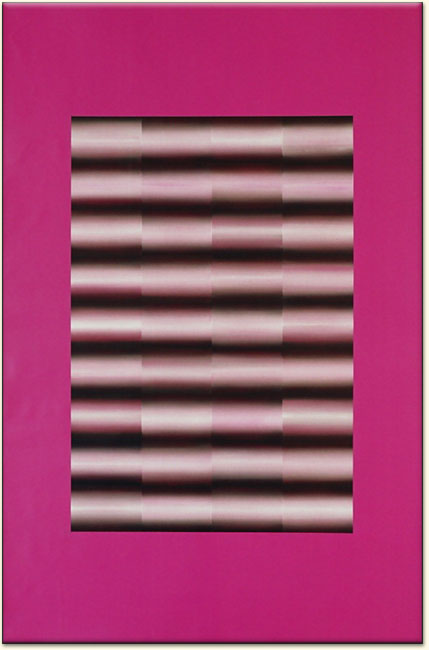Jegori Koski's Visualizations of Musical Rhythm
Like Lambie, the Paris-based Jegori Koski of Finnish origins (1947) associates his work with music. Unlike Lambie, who is interested in psychedelic pop and rock, Koski listens to Richard Strauss, Wolfgang Amadeus Mozart and Richard Wagner while painting, and his works can be interpreted as the visualizations of musical rhythm.
Koski’s art demonstrates how simple changes in the combinations of color and geometric form have a dramatic impact. Compare and contrast Koski’s Sequence No. 26 (2005) and Sequence No. 11 (2003). (If you have a large screen, enlarge Sequence No. 26, above right, and you can move it side-by-side with Sequence No. 11.) How has the artist created the effect of rhythmic movement? Do colors affect our perceptions of the works?

Sequence No. 11, Jegori Koski, 2003.
Sequence No. 26 plays between energetic movement and calm stability. Its brown center with vertical white stripes of light moves constantly. The edges of the light stripes appear blurred, suggesting movement. The stripes also appear as if they are made of several different pieces that are put together. Moreover, the stripes appear to be on the top of brown color, creating a misleading illusion of depth. The surrounding light green rectangle is more stable than the center. In its stability, it contrasts the energetic movement and balances the work.
Sequence No. 11 creates a very different effect. Instead of using light green in the outer rectangle, Koski has painted it in a pink that creates a nervous atmosphere. Therefore, the outer rectangle fails to stabilize the work and contributes to the energy of the center, painted in the horizontal forms of white, brown and pink.
Koski’s work is characterized by constant repetition of forms and colors. For Koski, repetition means continuity and reflects his interest in Egyptian mythology and in the Indian Veda literature, neither of which consider death as the end, but rather as the beginning of a new form. Thus, Koski’s repetition of colors and abstract forms can be seen symbolizing the continuity of life.
